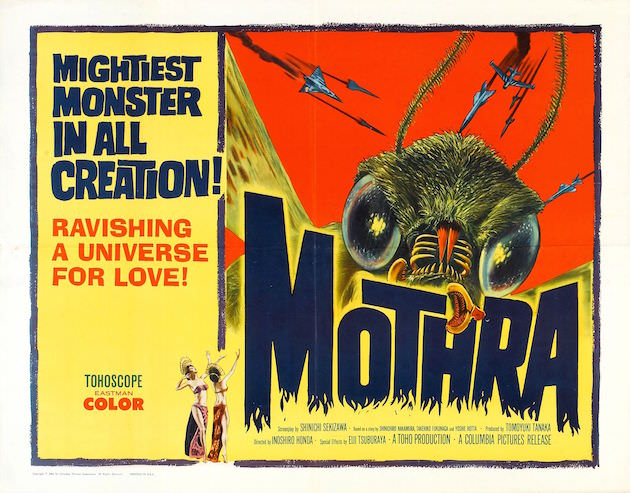From Jurassic World‘s Indominus Rex to Mothra: Who’s The Meanest of Them All?
When Jurassic World hits the cinemas tomorrow, we’ll finally discover exactly what the biggest baddest Jurassic dinosaur yet, Indominus Rex, is capable of… Before then we take a look at exactly what it’s up against from some of cinema’s memorable movie monsters, from Godzilla to Alien’s small but deadly Facehugger.
Indominus Rex
In 1993’s Jurassic Park, after some Hollywood tinkering with the science of cloning, the Tyrannosaurus Rex is brought back from its 65-million-year-old grave to entertain the masses at a theme park, eventually turning on it’s captors. If that’s not scary enough, in the latest installment of the franchise Jurassic World, the T. Rex is given an overhaul thanks to genetic engineering and becomes Indominus Rex “the most fearsome dinosaur ever to be displayed at Jurassic World”.
Length: currently 40 feet (same as the T. Rex).
Weight: TBD (however the T. Rex is 9 tons and this length).
Skills: Largest carnivore in its habitat. Can reach speeds of 30 mph (in its enclosure).
Description: Resembles the T. Rex but with distinctive head ornamentation and tough bony osteoderms. Indominus also sports horns above the eye orbit. Its roar can reach 140 to 160 db, which is about the same as a 747 taking off and landing.
Weakness: Unknown.
How it’ll get you: Hunt you down.
Godzilla (original 1954 version)
Film’s most famous city-smashing monster has been through several incarnations since its 1954 Japanese debut, when it appeared as a symbol of nuclear destruction following WWII. In last year’s Hollywood version Godzilla stands 350 feet tall (we found out how they created our most recent Godzilla’s roar, read about it here), compared with 164 feet in the Japanese original.
Height: 164 feet
Weight: 20,000 tons
Description: The huge scaly, fire-breather is a radioactive genetic mutation caused by nuclear testing in the Pacific Ocean. It emerges from the sea and resembles something from the prehistoric era.
Skills: Atomic ray, super regenerative power.
Weakness: Electricity.
How it’ll get you: If you don’t get stomped to death you’ll die later of radiation poisoning.
Mothra (original 1961 version)

When you think about scary creatures a moth is probably not the first one that pops into your head. But, Toho, the production company behind the original Godzilla, set out to change all that when Mothra first appeared in 1961. Like Godzilla, she went on to appear in several more films, including 1964’s Mothra vs Godzilla.
Length: 262 feet
Wingspan: 820 feet
Weight: 15,000 tons
Description: Mothra emerges from her cocoon resembling a giant combination of moth and butterfly. She is a benevolent creature from a tropical island close to the site of atomic testing and worshipped as a deity there. Usually accompanied by tiny twin fairies, she will do anything to protect them.
Skills: Flies at Mach 3 (three times the speed of sound), can create hurricanes with her wings.
Weakness: Her fairy companions.
How she’ll get you: You’ll be collateral damage of you get in between her and her fairies.
King Kong (original 1933 version)
Perhaps the most misunderstood of these havoc-wreaking creatures, King Kong resides on the mysterious Skull Island, along with several species of dinosaur, until he is discovered by a film crew scouting an exotic location to shoot. He is brought to New York to be exhibited as the ‘Eighth Wonder of the World’. Naturally, he escapes and chaos ensues. Like Godzilla, King Kong varies in size depending on the film, or sometimes within the film. In Peter Jackson’s 2005 version Kong is 25 feet tall, roughly the same size as the original Kong at his biggest.
Height: 18 to 24 feet tall (varies from scene to scene)
Description: A giant prehistoric ape, gorilla-like in appearance. Largely misunderstood by humans.
Skills: Intelligent, strong, skilled fighter.
Weakness: The ladies (specifically Ann Darrow).
How he’ll get you: You’ll get in his way when he’s trying to escape or save Ann Darrow, and he will pulverize you.
Cloverfield’s nameless monster (nicknamed Clover during production)
According to Cloverfield’s producer and creator J.J. Abrams, the monster he dreamed up to terrorize New York in his 2008 film, has deliberately sketchy origins. He reasons that if a monster did attack, people wouldn’t necessarily know exactly where it came from. We do know that Clover is a deep sea creature, who is disturbed from its slumber by a marine biologist and goes on to terrorizes New York.
Height: 240 to 300 feet
Weight: 5,800 tons
Length: 1,200 feet
Description: Clover is a quadruped with a long forked tail. It has thick, grey skin, bony features and a face like a piranha.
Skills: It is just a baby (an angry baby), so it’s main weapon is its size and physical strength. It also releases killer parasites, which are vicious, rabid, dog-like creatures.
Weakness: Age.
How it’ll get you: Eat you, squash you, the parasites will come for you, or you’ll be collateral damage. Just pray you don’t end up like Lizzie Caplan’s character Marlena.
Facehugger
In Ridley Scott’s Alien franchise, the Facehugger is the second stage in the titular alien’s life-cycle and scrambles around looking for hosts to impregnate. The 2012 prequel(ish) Prometheus, features the larger, but similar, Trilobite.
Size: Around 3 feet.
Description: A greenish squid-like parasite that tries to make contact with hosts’ mouths to implant its embryo. It wraps its tail around the host’s neck and inserts it a tube down their throat.
Skills: Moves stealthily, has strong tentacles.
Weakness: Dies after implantation.
How it’ll get you: Attempts to remove the Facehugger during the implantation process generally prove fatal. If it impregnates you, its spawn will errupt from your chest.
Featured image: Idominus Rex from Jurassic World. Courtesy Universal Pictures.



